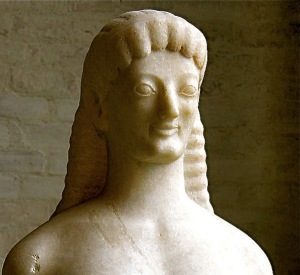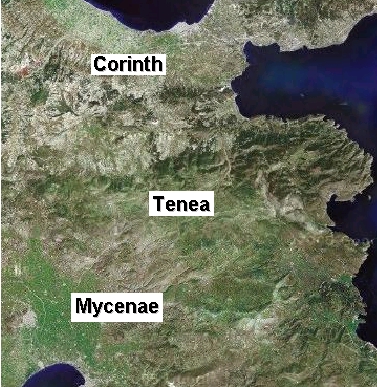
It was in July 1984 when rescue excavations conducted by Dr. Elena Korka, now Director of the Ephorate of Private Archaeological Collections and Antiquity Shops, turned up an ancient sarcophagus of the Greek early archaic period near the town of Chiliomodi in Greece. The sarcophagus contained a female skeleton along with offerings. The interior of the sarcophagus slab was adorned with a composition consisting of two lions of monumental character. It was a remarkable find.
But this was not altogether surprising, as archaeologists and historians believed that somewhere in the area the central structural remains of the city of Tenea likely existed. Established, according to written sources, not far from the ancient cities of Corinth and Mycenae shortly after the Trojan War, its first inhabitants were said to be Trojan prisoners of war settled there by Agamemnon. Tenea was considered to be the main settlement of the valley, situated strategically to control the way from Argos to ancient Corinth, and the historian Strabo wrote that Tenea was the location where the Corinthian king Polybius nursed Oedipus.
_____________________________
 _______________________________________
_______________________________________
Historically, other hints of Tenea’s real existence have emerged, such as the discovery of the Kouros statue in 1846, now housed in the Glyptothek Museum in Munich, and more recently two other archaic kouroi were found and seized by the police in 2010. Because of the importance of the finds, archaeologists conducted surveys in the area around the sarcophagus discovery and its surrounding region.
But the first full, systematic investigation in the area did not begin until 2013 under the direction Korka. With the help of Greek and foreign scholars, archaeologists, geologists, and students, Korka soon uncovered an archaic cemetery consisting of burial sites with archaic period enclosures. Korka believes the cemetery may be associated with the ancient city of Tenea itself.
“Only sporadic remains of the city have been discovered in the region…….such as the Munich kouros, the sarcophagus, and two archaic kouroi,” write Korka and colleagues. “It is thus most likely that substantial archaeological remains of this important ancient city are expected to come to light very soon.”*
Korka and her team hope to uncover much more in coming excavation seasons. They intend to return to the area in September of 2014 to continue where they left off in 2013.
More information about the effort and how one can participate can be obtained at http://www.archaeological.org/fieldwork/afob/15660.
Cover Photo, Top Left: The Kouros statue of Tenea in the Glyptothek Museum, Munich. Zde, Wikimedia Commons
* http://www.archaeological.org/fieldwork/afob/15660.
______________________________________________
Read about the most fascinating discoveries with a premium subscription to Popular Archaeology Magazine. Find out what Popular Archaeology Magazine is all about. AND MORE:
On the go? Purchase the mobile version of the current issue of Popular Archaeology Magazine here for only $2.99.
Popular Archaeology’s annual Discovery Edition eBook is a selection of the best stories published in Popular Archaeology Magazine in past issues, with an emphasis on some of the most significant, groundbreaking, or fascinating discoveries in the fields of archaeology and paleoanthropology and related fields. At least some of the articles have been updated or revised specifically for the Discovery edition. We can confidently say that there is no other single issue of an archaeology-related magazine, paper print or online, that contains as much major feature article content as this one. The latest issue, volume 2, has just been released. Go to the Discovery edition page for more information.






